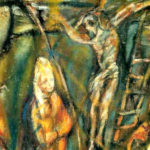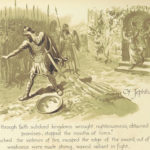We run our website the way we wished the whole internet worked: we provide high quality original content with no ads. We are funded solely by your direct support. Please consider supporting this project.

The Greatest in the Kingdom (2 of 2)
Article by Natalie Frisk
This post is a summary of what was discussed at the ReKnew CrossVision Conference in regard to what and how we teach our kids about the cruciform hermeneutic.
Taking Jesus into the Old Testament
I co-lead a family-friendly home church where we sometimes get into spiritually deep conversations with children. There is a ten-year-old girl, a neighborhood kid, who attends without her parents. She has told us that her mom isn’t really “into church.” This girl, we’ll call Hannah, was sharing one day about trying to help her mom understand who Jesus is. She said, “It’s as if my mom’s idea of God or Jesus is like she sees him through frosted glass. She has an idea of who is on the other side of the glass, but it is really blurry. She doesn’t see Jesus clearly.”
Hannah had no idea how profound that statement had been. So many people in life only see God through a frosted glass. They can see an outline, but it is hardly a glimpse of who he really is.
In my previous post, I talked about how we begin a spiritual foundation for our kids by teaching them Jesus, Jesus, Jesus. I cannot overstate how important it is for a child’s portrait of God to begin in Jesus. Jesus shows us: God is love. Jesus is the fullest revelation of who God is. In fact, Colossians 2:9 says, “God’s whole nature is living in Christ in human form.” Previous revelation was only a glimpse. It was God behind the frosted glass. Jesus is the full picture. This understanding will inform a child’s view of God well into adulthood.
In addition to this, I have always taught children (from very young ages) the crucifixion account. They won’t understand the full impact of the cross (I mean, I’m an adult, and I’m sure I don’t), but they will see that this Jesus, who we call God With Us, was willing to die because of his great love for us. Young children understand it is sad, but happy. Important, but hard. Kids get this more than we realize.
I recall reading a children’s Bible story book of the death and resurrection of Christ to my daughter when she wasn’t quite two years old. She said, “Sad story, mommy,” at the death of Jesus, but I told her it doesn’t stay sad. And, once we got to the end and celebrated together that Jesus is alive, she asked to read it again. Helping kids slow down and take some time to discover the crucified and resurrected Christ is huge. It is also important in helping them wade into the Old Testament in a secure way.
I once heard someone say, “Every time I enter into the OT, I make sure I take Jesus with me.” Without Jesus, the Old Testament is just plain brutal, especially for young children. So, when and how do we introduce the OT to our children? I don’t think I have a definitive answer. There are many conflicting views about when to introduce OT stories to our kids, but here are a few thoughts:
- Kids are sponges. During this key developmental time, they are acquiring vast loads of information, including establishing a repertoire of stories that frame their lives and understanding of the world.
- Old Testament stories can be engaging and interesting to kids; however, we do tend to try to wrap them up into a morality lessons for small children which isn’t always helpful (especially when it comes to violent accounts).
- Kids do tend to model what they learn. Kids who learn about a battle or fight will want to play act that out.
- The information kids learn in their early years, along with the repetition of that information throughout their growth, will stick with them for an incredibly long time.
The truth is every kid is different. Some will have greater sensitivities to violence than others. Taking age and developmental stage (as well as emotional development) into account is important. In truth, you’ll have to pray for the wisdom of when to begin these learnings with your own children. There really isn’t a set answer for everyone. However, what I can tell you is that it is possible to help our kids hear these stories as they are presented in Scripture and be able to view them through a cruciform hermeneutic. We do this by inviting them to put on their “cross vision” or “cross lenses” to see what was going in the story.
This can be done in each biblical account by debriefing with questions such as:
For some reading this, it may seem like a bit of a developmental leap. But in our present time and culture, kids are incredibly well-versed in the realities of different cultures and story worlds; detail is not lost on kids. As such, explaining the world and culture of the biblical story, actually makes sense to them. Instead of trying to create a nicely wrapped morality lesson out of the OT narratives, we should be inviting kids into the bigger picture: how does this point to Jesus? Did Jesus interact with this story when he was on earth? And how can we see a glimpse of God in this story in some way?
One of the greatest gifts we can give our children is to let them see us asking questions, wrestling with those questions, and discovering that they, too, are invited to ask questions. As we point our kids to Jesus, we can help them discover the shape behind the frosted glass is our beautiful Lord Jesus Christ.
Category: General, Guest Contributor
Tags: Cross Vision, Crucifixion of the Warrior God, Cruciform Theology, Kids
Guest Contributor:

Natalie Frisk serves as the curriculum pastor at The Meeting House – a multisite church in Canada, overseeing the development of kids and youth teaching from birth to end of high school. She’s been in pastoral ministry for over a decade in an ever-changing multisite landscape. Natalie is presently working towards a Doctor in Practical Theology (McMaster Divinity College) with a focus on the spirituality of children. She is the author of a new book, Raising Disciples: How to Make Faith Matter to Our Kids (Herald Press, 2019) that is presently available for pre-order now.
Related Reading

The Ultimate Criteria for Theology
Theology is thinking (logos) about God (theos). It is a good and necessary discipline, but only so long as it is centered on Christ. All of our speculation and debate about such things as God’s character, power, and glory must be done with our focus on Jesus Christ—more specifically, on the decisive act by which…

Podcast: HOW Does the Death of Jesus Allow Us to Be Forgiven?
Greg discusses love bombs and explosions of light. http://traffic.libsyn.com/askgregboyd/Episode_0419.mp3

God’s Kind of Warfare
Over and over, and in a variety of different ways, we are told that, while “[s]ome trust in chariots and some in horses,” Israelites were to “trust in the name of the LORD our God” (Ps 20:7), for “[n]o king is saved by the size of his army” and “no warrior escapes by his great…

Sending Evil Spirits
In several infamous biblical depictions of Yahweh in the Old Testament, God is depicted as “sending” spirits to trouble and/or deceive people (Judg 9:22-3; 1 Sam 16:14, 23; 18:10; 19:9; 1 Kg 22:20-3). While there are several exegetical considerations that arguably help alleviate the problematic way these passages implicate God in unethical behavior, I nevertheless…

One Hope
When Jesus was crucified by his enemies instead of conquering his enemies, the hope of Jesus’ disciples came crashing down in utter despair. They had hoped that Jesus would establish the kingdom of God in the same way that other kingdoms were established. However, the resurrection reveals that the kingdom of God is not like…

Does Hebrews 11 Praise Violence? A Response to Paul Copan (#2)
Once or twice a week, as time allows, I will be responding to criticisms of Crucifixion of the Warrior God (CWG) that were raised by Paul Copan in a recent paper that he delivered at the Evangelical Theological Society. In my first post in this series I responded to Copan’s claim that Paul’s quotation from…
